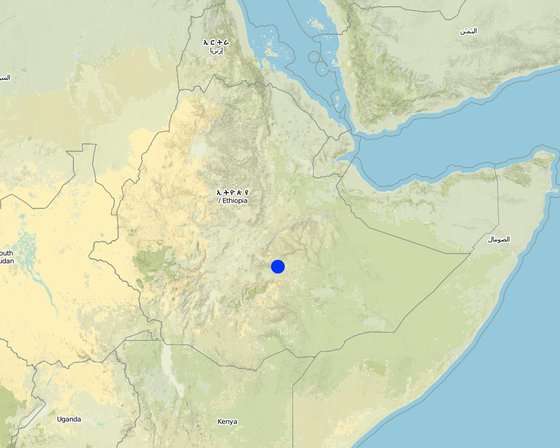

Soil bund and Fanya Juu constructed in combination in a microwatershed for retaining maximum possible rain water in the soil by obstructing runoff water. Soil bunds are suitable for steeper slopes compared to fanya juu terraces which are more effective in gentle and flatter slopes.Land users in the SWC area prefer to combine the two physical structures for many reasons.One important factor is the cost of establishment, which is a function of labour needed for the construction. Fanya juu which means throwing soil upslope in Kiswahili intails throwing soil upslope which is more labours than throwing soil to downslope in the case of soil bunds. The other reason is that cultivated lands with fanya juu terraces are not easily accessed by free grazing livestock. The ditches placed in the downslope side of the embankment (fanya juu) is not easily vrossable but in soil bund although not that easy livestock are seen to trample over the embankment and jump the ditch which is placed in the upslope side. The other advantage farmers consider is that Fanya juu is more efficient in controlling runoff because the water that overtops the embankment is trapped by the ditch. Fanya Juu despite its high cost is preferred to be applied in combination with bunds because of the other advantage that it forms bench terrace rapidly.
Purpose of the Technology: The major purpose is to trap as much rain water as possible and also control soil erosion. Cultivated lands with with Soil bund and Fanya Juu have shown remarkable improvement in soil moistureavailability to crops compared to fields with no measures.
Establishment / maintenance activities and inputs: Soil bund and Fanya Juu are established in the same way by digging soil from and embanking it on a contour line. A contour line is laid out by following zero gradient. Once the soil is dug and embanked it is lightly compacted to avoid colapse. To further ensure bund stabilityuseful trees/shrubs are planted.The planted tree/shrub species are those offering multiuses such as fodder, fertility improving and fuelwood. Maintenance: It is done by repairing breaks and managing planted trees on the structure or by upgrading the structure by increasing its height and plant improved tree and fruit tree species.
Natural / human environment: The technology is suitable to semiarid climatic condition which have erratic rains and where crop production is limited by soil moisture stress. Soils in the technology area are susceptable to erosion and therefore the structure should be stablized by planting trees or grass species.

Localização: Oromia, Oromia, Etiópia
Nº de sites de tecnologia analisados:
Difusão da tecnologia:
Em uma área permanentemente protegida?:
Data da implementação: menos de 10 anos atrás (recentemente)
Tipo de introdução







| Especifique a entrada | Unidade | Quantidade | Custos por unidade (Birr) | Custos totais por entrada (Birr) | % dos custos arcados pelos usuários da terra |
| Mão-de-obra | |||||
| Labour | ha | 1,0 | 199,0 | 199,0 | 20,0 |
| Equipamento | |||||
| Tools | ha | 63,0 | 5,0 | ||
| Material vegetal | |||||
| Seeds | ha | 1,0 | 8,0 | 8,0 | 100,0 |
| Custos totais para a implantação da tecnologia | 207.0 | ||||
| Custos totais para o estabelecimento da Tecnologia em USD | 24.07 | ||||
| Especifique a entrada | Unidade | Quantidade | Custos por unidade (Birr) | Custos totais por entrada (Birr) | % dos custos arcados pelos usuários da terra |
| Mão-de-obra | |||||
| Labour | ha | 1,0 | 13,0 | 13,0 | 100,0 |
| Custos totais para a manutenção da tecnologia | 13.0 | ||||
| Custos totais de manutenção da Tecnologia em USD | 1.51 | ||||
due to soil moisture improvement
bund stablization and area enclosure
bund stablization and area enclosure
homesteads intensification
farmers' groups for development work getting strengthened
land users have developed skills in marking contours and constructing bunds.
Quantidade anterior à GST: 50
Quantidade posterior à GST: 0
because of structural measures
integrated measures
leguminous plants and compost application
because of reduced runoff on uphills
reduce soil erosion